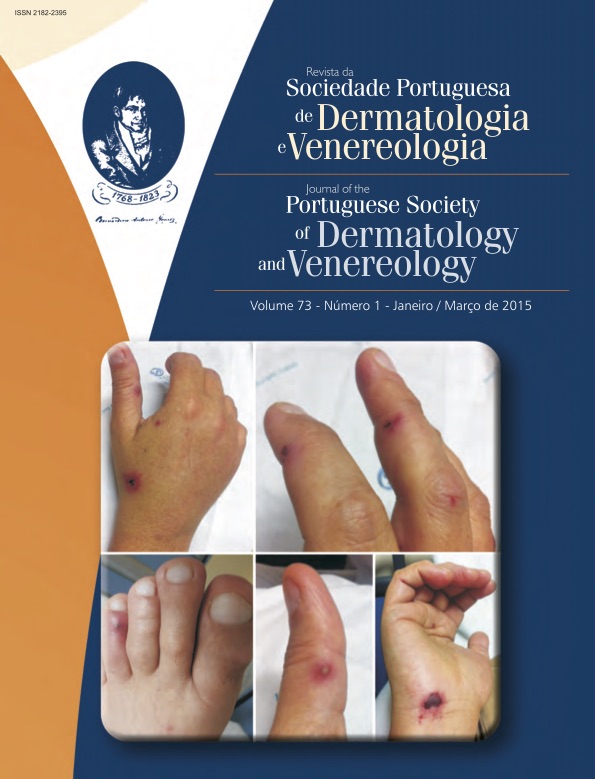ATYPICAL FIBROXANTHOMA: CLINICOPATHOLOGICAL REVIEW
Abstract
Introduction: Atypical fibroxanthoma (AFX) is a rare cutaneous tumor without a completely defined histogenesis which frequently develops on head and neck of elderly people. Its diagnosis is histological, of exclusion with other tumors with identical morphology. Despite its classical benign behavior some rare cases reporting distant metastasis classified it on intermediate malignancy.
Material and methods: We preformed a retrospective analysis with purpose of reviewing the AFX diagnosis made in our department between 2008 and 2014. We analyzed demographic, clinical, histological and immunohistochemical data and also surgical treatment and recurrence.
Results: We obtained 12 cases of AFX, 11 males and 1 female, the youngest was 25 years old and the others had a median age of 76 years. The lesions were nodules or tumors with 1.9cm median size, all of them located on the head. Histology revealed well defined lesions with atypical pleomorphic cells and frequent solar elastosis, classified as mix variant (spindle and histiocytic cells) in all cases. Immunohistochemical study showed positivity for vimentin and negativity for cytokeratins and S100 protein in all cases and CD10 and CD99 were frequently positive. Surgical excision was performed in 10 cases with 10% rate of recurrence during 3 years of median follow-up.
Conclusions: These results were similar with other published series. This tumor is clinically unspecified and histologically undifferentiated and so immunohistochemistry is essential for diagnosis, however, for now, available makers are not sufficiently specific. Despite its good prognosis in most cases clinical surveillance is recommended.
Downloads
References
Fretzin DF, Helwig EB. Atypical fibroxanthoma of the skin – A clinicopathologic study of 140 cases. Cancer. 1973; 31(6):1541-52.
Helwig EB. Atypical fibroxanthoma. Text J Med. 1963; 59:664-7.
Weedon D, Kerr JF. Atypical fibroxanthoma of skin: an electron microscope study. Pathology. 1975(3); 7:173-7.
Woyke S, Domagala W, Olszewski W, Korabiec M. Pseudosarcoma of the skin: an electron microscopic study and comparison with the fine structure of spindle-cell variant of squamous carcinoma. Cancer. 1974; 33(4):970-80.
Lee CS, Chou ST. P53 protein immunoreactivity in fibrohistiocytic tumors of the skin. Pathology. 1998; 30:272-5.
Dei Tos AP, Maestro R, Doglioni C, Gasparotto D, Boiocchi M, Laurino L, et al. Ultraviolet-induced p53 mutations in atypical fibroxanthoma. Am J Pathol. 1994; 145(1):11-7.
Patterson JW, Jordan WP Jr. Atypical fibroxanthoma in a patient with xeroderma pigmentosum. Arch Dermatol. 1987; 123(8):1066-70.
Dilek FH, Akpolat N, Metin A, Ugras S. Atypical fibroxanthoma of the skin and the lower lip in xeroderma pigmentosum. Br J Dermatol. 2000; 143(3):618-20.
Mirza B, Weedon D. Atypical fibroxanthoma: a clinicopathological study of 89 cases. Australas J Dermatol 2005; 46(4):235-8.
Ang GC, Roenigk RK, Otlev CC, Kim Phillips P, Weaver AL. More than 2 decades of treating atypical fibroxanthoma at mayo clinic: what have we learned from 91 patients? Dermatol Surg. 2009; 35(5):765-72.
Kargi E, Gungor E, Verdi M, Kuiaçogiu S, Erdogan B, Alli N, et al. Atypical fibroxanthoma and metastasis to the lung. Plas Reconstr Surg 2003; 111(5):1760-2.
Giuffrida TJ, Kligora CJ, Goldstein GD. Localized cutaneous metastases from an atypical fibroxanthoma. Dermatol Surg. 2004; 30(12): 1561-4.
Lum DJ, King AR. Peritoneal metastases from an atypical fibroxanthoma. Am J Surg Pathol. 2006; 30(8):1041-6.
Luzar B, Calonge E. Morphological and immunohistochemical characteristics of atypical fibroxanthoma
with a special emphasis on potential diagnostic pitfalls: a review. J Cutan Pathol. 2010; 37(3):301-9.
Iorizzo LJ, Brown MD. Atypical fibroxanthoma: a review of the literature. Dermatol Surg. 2011; 37(2): 146-57.
Hollmig ST, Rieger KE, Henderson MT, West RB, Sundram UN. Reconsidering the diagnostic and prognostic utility of LN-2 for undifferentiated pleomorphic sarcoma and atypical fibroxanthoma. Am J Dermatopathol. 2013; 35(2):176-9.
MCCalmont TH. AFX: what we now know. J Cutan Pathol. 2011; 38(11):853-6.
Gru AA, Santa Cruz DJ. Atypical fibroxanthoma: a selective review. Semin Diagn Pathol. 2013; 30(1):4-12.
Dotto J, Glusac E. Best practices in diagnostic immunohistochemistry: pleomorphic cutaneous spindle cell tumors. 2008; 132(5):732.
Gray Y, Robidoux HJ, Farrel DS, Robinson-Bostom L. Squamous cell carcinoma detected by high-molecular- weight cytokeratin immunostaining mimicking atypical fibroxanthoma. Arch Pathol Lab Med 2001; 125(6):799-802.
Sigel JE, Skacel M, Bergfeld WF, House NS, Rabkin MS, Goldblum JR. The utility of cytokeratin 5/6 in the recognition of cutaneous spindle cell squamous cell carcinoma. J Cutan Pathol. 2001; 28(10):520-4.
Sakamoto A, Oda Y, Yamamoto H, Oshiro Y, Miyajima K, Itakura E, et al. Calponin and h-caldesmon expression in atypical fibroxanthoma and superficial leiomyosarcoma. Virchows Arch. 2002;440(4):404-9.
Hafner J, Kunzi W, Weinreich T. Malignant fibrous histiocytoma and atypical fibroxanthoma in renal transplant recipients. Dermatology. 1999; 198(1):29-32.
Kanitakis J, Euvrard S, Montazeri A, Garnier JL, Faure M, Claudy A. Atypical fibroxanthoma in a renal graft recipient. J Am Acad Dermatol. 1996; 35(2):262-4.
Ferri E, Iaderosa GA, Armato E. Atypical fibroxanthoma of the external ear in a cardiac transplant recipient: case report and the causal role of the imunosuppressive therapy. Auris Nasus Latynx. 2008; 35(2):260-3.
All articles in this journal are Open Access under the Creative Commons Attribution-NonCommercial 4.0 International License (CC BY-NC 4.0).








